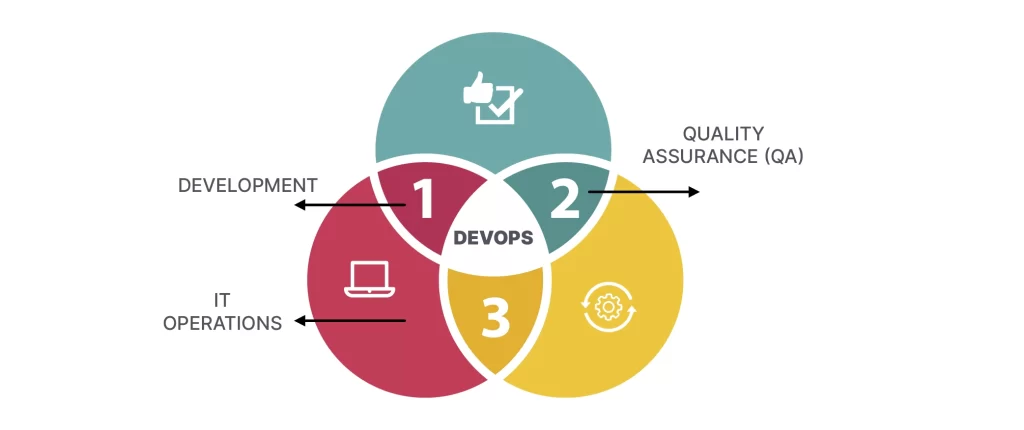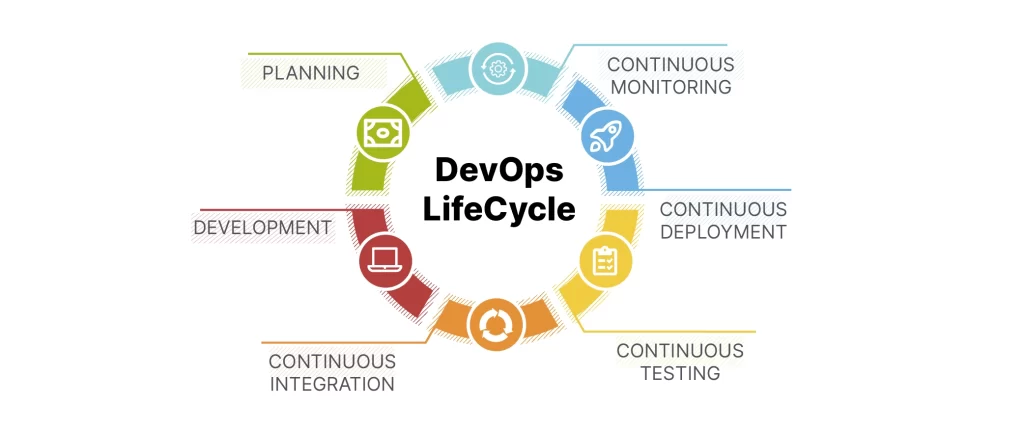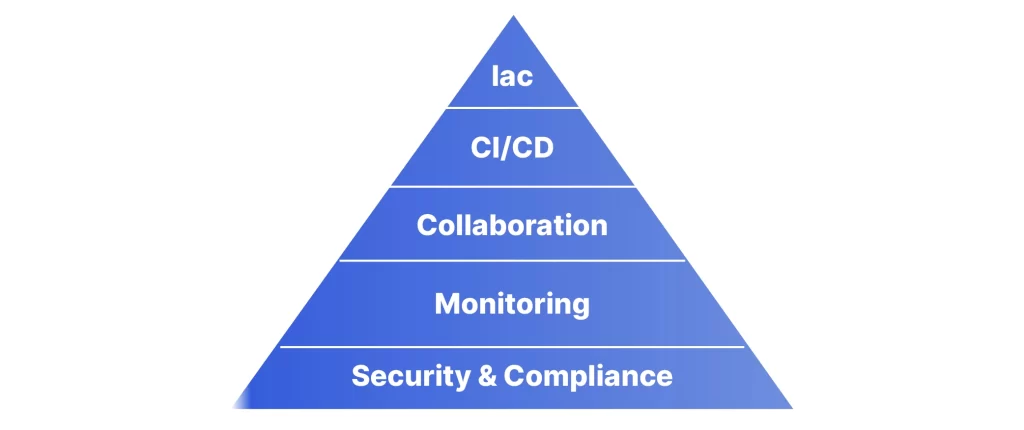DevOps – A comprehensive set of adaptable practices aiming to bridge the gap between software development and IT operations.
In this today’s fast-paced cyberspace, DevOps has emerged as a paradigm shift in software development and delivery. Additionally, the DevOps lifecycle is the foundation of efficient application development and delivery practices. We’re going to dive into the DevOps lifecycle, which helps organizations succeed in continuous integration, testing, deployment, and monitoring by streamlining their operations. Moreover, this article will give readers an in-depth understanding of What is DevOps, its significance in software development, the DevOps process, and how it has altered businesses worldwide.
DevOps, to explain it simply, is a detrimental methodology that brings combined software development (Dev) and IT operations (Ops) to produce an uninterrupted and effective workflow.

In order to close the gap between development teams and operations teams and enable speedier software delivery with better quality and reliability, DevOps places enormous value on cooperation, communication, and automation. Let’s discuss the importance of DevOps in software development.
A number of benefits can be derived from the software development ecosystem, which is crucial for DevOps, which enables organizations to:
Shorter Market Entry Time | Enable quicker delivery of software products and features, allowing organizations to foster partnerships for maximizing processes. |
Greater Collaboration | Enabling cross-functional collaboration and cutting down organizational silos with improved communication amongst development and operations teams. |
Higher Reliability | DevOps declines system failures and delays by automating deployment, monitoring, and error detection, which leads to a stable and dependable software environment throughout. |
Scalability & Flexibility | Infrastructure as code (IaC) and cloud technologies allow organizations a way to quickly scale their software solutions in order to adapt to changing customer requirements. |
Continuous Integration & Delivery | Endorses a seamless and solid release process, lowering error and improving software quality, using automated testing, continuous integration, and continuous delivery pipelines. |
DevOps has grown and matured over time, transforming how businesses create and deploy software. However, businesses can now stay forward in the digital age thanks to this evolution, which has had an important effect on them:
Development and operations teams usually function in silos, which has caused conflicts and slowness. By encouraging cooperation, collaboration, shared accountability, and cross-functional teams, DevOps revolutionized this methodology.
Automation was a DevOps turning point that streamlined time-consuming, repetitive chores so that teams could focus on coming up with new ideas and providing value. The software development process comprises automated testing, continuous integration, and deployment pipelines.
DevOps triggered a change in organizational culture that focused a greater value on collaboration, interaction, and continuous improvement.
DevOps embraces notions including; iterative development, constant feedback, and waste reduction, borrowing influence from Agile and Lean approaches. This connection has considerably shortened the lifespan of software development.

In this initial phase, organizations lay out their project objectives, specify user needs, and create a precise development roadmap. An understanding of the project’s goals among stakeholders, developers, and operations teams is facilitated by close collaboration across these groups.
The development and coding step starts when the planning stage is finished. In order to write code, implement features, and create the software, development teams use agile approaches and collaborative technologies. Systematic cooperation and change management are made possible by version control.
The crucial phase of continuous integration is where programmers routinely merge their code modifications into a shared repository. Teams can detect conflicts, spot issues early, and maintain code stability thanks to automation tools and build servers, which streamline the integration process.
An essential component of the DevOps lifecycle is continuous testing. It entails a thorough set of automated tests that confirm the software’s usability, effectiveness, and security. Organizations can run tests continuously, find issues, and give quick feedback to development teams thanks to test automation frameworks.
In order to achieve a seamless and effective software deployment, continuous deployment places a strong emphasis on automating the release process. Deployment pipelines are used by organizations to automate the installation and configuration of software in diverse contexts. This phase expedites the delivery of new features and upgrades to end customers while ensuring consistency and reducing human error.
Gaining insights into program performance and user experience requires continuous monitoring. Organizations can check system data, find abnormalities, and take preventative measures to deal with possible problems thanks to monitoring tools and procedures. Real-time monitoring contributes to the upkeep of system dependability, performance optimization, and user happiness.
In the world of DevOps, IntellicoWorks use key principles and best practices to drive successful software development and delivery. Let’s explore them through a single image representing DevOps excellence.

By adhering to these key principles and best practices, organizations can achieve DevOps excellence. This single image encapsulates the essence of automation, continuous integration and delivery, collaboration, monitoring, and security, empowering your DevOps journey.
Let’s examine them one by one in a little more detail;
1. Iac: Iac refers to automation and infrastructure as code that helps streamline tasks, reduce errors, and ensure consistency.
2. CI/CD: CI/CD refers to continuous integration and continuous delivery that is a process of (Merging code changes frequently, automating builds and testing, and enabling rapid and reliable software deployments.
3. Collaboration: Communication and cross-functional collaboration are essential for shared responsibilities and open communication channels to enhance productivity and innovation.
4. Monitoring: Feedback Loops are a must to establish comprehensive monitoring systems and feedback loops to gather real-time data, identify issues, and drive continuous improvement.
5. Security and Compliance: Integrate security practices throughout the DevOps lifecycle, automate security testing, and ensure compliance with regulatory requirements.
Microservices architecture and containerization are transforming the way software is developed and deployed. By breaking applications into smaller, loosely coupled services and running them in lightweight containers, organizations gain flexibility, scalability, and easier management of complex systems.
Serverless computing and Function as a Service (FaaS) allow developers to focus solely on writing code without worrying about server management. With serverless platforms, applications are built around event-driven functions that scale automatically based on demand, reducing operational overhead and enabling faster development cycles.
DevSecOps emphasizes the integration of security practices throughout the entire DevOps lifecycle. By integrating security measures early on, automating security testing, and fostering collaboration between development, operations, and security teams, organizations can effectively address vulnerabilities and ensure robust security within their software.
Artificial Intelligence (AI) and Machine Learning (ML) are revolutionizing DevOps by automating tasks, improving decision-making, and enhancing efficiency. AI-powered tools can analyze vast amounts of data, identify patterns, and provide valuable insights for continuous monitoring, automated testing, and anomaly detection in the software development process.
To sum up we can say that throughout our exploration, we have covered the DevOps lifecycle, detailed the DevOps process, highlighted key principles and best practices, and examined emerging trends and technologies. This is evident that DevOps offers a powerful framework for optimizing software development and delivery processes, enabling businesses to adapt to the demands of the fast-paced and competitive digital landscape.
Thus, DevOps is not merely a methodology but a transformative cultural shift that revolutionizes software development and delivery. Moreover, IntellicoWorks is a leading DevOps services & consulting company that provides DevOps, SecOps, and DataOps services to encourage you to embark on your DevOps journey by embracing a proactive mindset, fostering collaboration, automating processes, and leveraging emerging technologies to unlock the full potential of DevOps.
Follow IntellicoWorks for more insights!
DevOps is a software development approach that emphasizes collaboration, communication, and integration between software development (Dev) and IT operations (Ops) teams. It aims to streamline the software delivery process, enhance agility, and improve overall organizational performance.
Traditional software development follows a linear and siloed approach, with separate development and operations teams working in isolation. In contrast, DevOps promotes cross-functional collaboration, continuous integration, automated testing, and frequent software deployments. It breaks down the barriers between development and operations, enabling faster delivery, improved quality, and increased efficiency.
Implementing DevOps offers several benefits, including

Talk to us and let’s build something great together
A Subsidiary of Vaival Technologies, LLC
IntelliCoworks is a leading DevOps, SecOps and DataOps service provider and specializes in delivering tailored solutions using the latest technologies to serve various industries. Our DevOps engineers help companies with the endless process of securing both data and operations.
Ops
Cloud
AI & ML
Copyrights © 2023 byIntellicoworks. All rights reserved.